Καρέκλες: Μια μακρά ιστορία αλλαγών
DS.WRITER:
Christina Ioakeimidou
Peacock-Inspired Chair του Marc Ange | Πηγή εικόνας: galeriemagazine.com
Οι καρέκλες είναι ένα αναπόσπαστο κομμάτι της καθημερινότητάς μας. Όλοι προσπαθούμε να βρούμε μία που να ανταποκρίνεται στις εξατομικευμένες ανάγκες μας, είτε αυτές αφορούν τον εργασιακό (καρέκλες γραφείου) είτε τον προσωπικό χώρο (τραπεζαρία, δωμάτιο κτλ). Από τον άκρως λιτό αρχαίο κλισμό (μια απλή ξύλινη καρέκλα με κυρτή πλάτη και κωνικά πόδια), που χαρακτηριζόταν από την πρακτικότητα του σχεδιασμού, ως τον θρόνο -ας μην ξεχνάμε ότι πρόκειται για μία περίτεχνα σχεδιασμένη καρέκλα-, το κάθισμα είναι το σημαντικότερο αντικείμενο στον σχεδιασμό επίπλων, αφού πρέπει να είναι βολικό και συνάμα να αναδεικνύει, κατά κάποιον τρόπο, τον ρόλο του «ιδιοκτήτη» του. Παράλληλα, ο τρόπος σχεδιασμού και διακόσμησης μιας καρέκλας απεικονίζει και την εποχή, καθώς μέσω αυτών μπορούμε να δούμε τον τρόπο λειτουργίας και προσανατολισμού των κοινωνιών. Γι΄ αυτό θα τολμήσουμε να πούμε ότι, όσα είναι τα σχέδια της καρέκλας, τόσες είναι και οι ιστορικές και κοινωνικές αλλαγές.
Από την αρχαιότητα στον Μεσαίωνα
Η ιστορία της καρέκλας ακολουθεί παράλληλη πορεία με αυτήν του ανθρώπου, αφού κατάλοιπα καθισμάτων ανακαλύπτονται συχνά σε αρχαιολογικές ανασκαφές. Άλλωστε, ένα από τα πιο πολυσυζητημένα αρχαιολογικά ευρήματα, η λεγόμενη «Αίθουσα του Θρόνου» της μινωικής Κνωσού, πήρε το όνομά της από το κεντρικό κάθισμα που βρέθηκε στον συγκεκριμένο χώρο, οδηγώντας τήν τότε έρευνα στο συμπέρασμα πως επρόκειτο για το κεντρικότερο και σημαντικότερο δωμάτιο του συγκροτήματος, εξαιτίας του μεγάλου κεντρικού καθίσματος.

Η «Αίθουσα του Θρόνου», Κνωσός | Πηγή εικόνας: odysseyadventures.ca
Φυσικά, όταν μιλάμε για αρχαίες καρέκλες δεν αναφερόμαστε μόνο στους θρόνους, αλλά σε κάθε λογής καθίσματα, τα οποία έπρεπε να προσφέρουν άνεση, επιτείνοντας και τη μορφή του γεγονότος που λάμβανε χώρα στην εκάστοτε αίθουσα. Παραδείγματα τέτοιων ειδικών καθισμάτων ήταν αυτά που συναντούμε σε θρησκευτικούς χώρους -αν και τα καθίσματα αποτελούν κάπως σπάνιο αρχαιολογικό εύρημα-, σε στάδια ή σε χώρους δημόσιων συναθροίσεων. Στις τελευταίες μάλιστα, τα καθίσματα -στην ουσία επρόκειτο για χτιστούς πάγκους- ήταν σχεδιασμένα με γνώμονα το να μπορούν όλοι ανεμπόδιστα να συμμετέχουν στη συζήτηση που λάμβανε χώρα στην αίθουσα.
Ωστόσο, δεν φαίνεται να έχουμε την ίδια διάθεση ισότητας στα θέατρα. Σε αυτά, αν και τα διαζώματα αποτελούνταν από όμοιας μορφής καθίσματα, υπήρχε πάντα η πρόβλεψη της προεδρίας, της πρώτης δηλαδή σειράς καθισμάτων στο κατώτερο και κεντρικότερο σημείο του κοίλου, η οποία προοριζόταν για τους επισήμους. Έτσι, η προεδρία δεν ήταν απλώς ένας πάγκος, αλλά μία διαμορφωμένη καρέκλα, ανετότερη των υπόλοιπων καθισμάτων, ενώ κάποιες φορές έφερε και επιγραφές ή άλλα ανεπαίσθητα διακοσμητικά στοιχεία. Χαρακτηριστικότερο παράδειγμα τέτοιων θρόνων βρίσκουμε στο Θέατρο του Διονύσου στην Αθήνα.
Περνώντας στη Ρωμαϊκή εποχή, όπου όλα περιστρέφονταν γύρω από τον αυτοκράτορα, έχουμε την εμφάνιση διακοσμημένων καρεκλών ή επιμήκων καθισμάτων (subsellium) κατασκευασμένων από διάφορα υλικά, τα οποία ποίκιλλαν ανάλογα με το κύρος του ιδιοκτήτη, αν και συχνότερα συναντώνται οι ξύλινες καρέκλες. Φυσικά, οι θρόνοι (Cathedra) -καρέκλες με πολύ ψηλή πλάτη και βραχίονες- εξακολουθούν να υφίστανται, τώρα όμως με έντονη διακόσμηση. Αυτού του τύπου η καρέκλα, ωστόσο, δεν συναντάται μόνο σε ανάκτορα ή στις οικίες των υψηλά ιστάμενων, αλλά και σε χώρους λατρείας, αφού γενικά προορίζονται για άτομα με κάποιο ιδιαίτερο αξίωμα, όπως ήταν και οι ιερείς. Το φαινόμενο θα γίνει εντονότερο κατά τη βυζαντινή εποχή και τον Μεσαίωνα, όπου ο ανταγωνισμός μεταξύ του εκάστοτε αυτοκράτορα και του Πατριάρχη ή του Πάπα διαρκώς μεγάλωνε.

«Θρόνος του Καρλομάγνου» (Άαχεν, 9ος αιώνας μ.Χ.) | Πηγή εικόνας: reddit.com
Ωστόσο, η ερώτηση που εύλογα θα προκύψει από τα παραπάνω είναι η εξής: Τι σχέση έχουν οι μεσαιωνικοί θρόνοι με το design όπως το ξέρουμε σήμερα, και πώς μια καρέκλα μπορεί να αντανακλά μια συγκεκριμένη τάξη ή κοινωνική συνθήκη;
Η απάντηση μπορεί να είναι εύκολη, αν, αρχικά, φέρουμε στο μυαλό μας τον λεγόμενο «Θρόνο του Καρλομάγνου» (9ος αιώνας μ.Χ.) στο Άαχεν, και στη συνέχεια παραλληλίσουμε τον σχεδιαστικό τύπο του με αυτόν της Charlemagne chair (Baxton Studio), η οποία ήταν εμπνευσμένη από τις γαλλικές καρέκλες που συχνά υπήρχαν στις οικίες ατόμων της ευρωπαϊκής αριστοκρατίας. Ίσως, λοιπόν, ένας προκαθορισμένος τύπος χρησιμοποιούνταν για συγκεκριμένους ιδιοκτήτες, με σκοπό την ανάδειξη της κοινωνικής και οικονομικής τους θέσης.
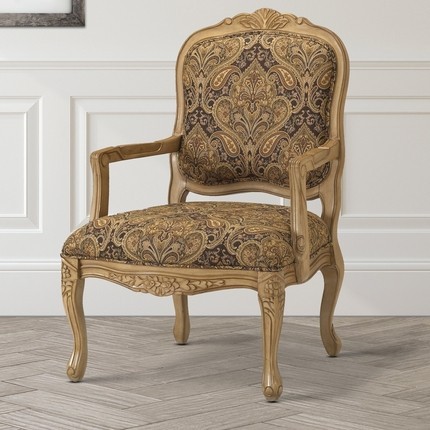
Πηγή εικόνας: foter.com
Μήπως, λοιπόν, άθελά μας ταυτίζουμε τον τύπο της καρέκλας με μία συγκεκριμένη κοινωνική θέση; Είναι ένα τόσο συνηθισμένο αντικείμενο ικανό να σηματοδοτήσει κοινωνικές και τεχνολογικές αλλαγές;
Ο Michael Thonet και η «επανάσταση» της καρέκλας
Προφανώς θα ήταν ένα λογικό άλμα, αν από τον Μεσαίωνα φτάναμε κατευθείαν στον 19ο αιώνα, όταν δραστηριοποιήθηκε ο M. Thonet. Εντούτοις, κατά τη διάρκεια των αιώνων που μεσολάβησαν, δεν παρατηρήθηκε κάποια καινοτόμα αλλαγή στον τρόπο κατασκευής και αντίληψης της καρέκλας, αφού, όπως προαναφέρθηκε, τα υλικά, η διακόσμηση και ο τρόπος κατασκευής διέφεραν ανάλογα με τον ιδιοκτήτη. Φυσικά, δεν παραβλέπουμε τις εποχές-σταθμούς στον χώρο των Τεχνών, όπως την Αναγέννηση, το Μπαρόκ ή το Ροκοκό. Και σε αυτές τις χρονικές περιόδους συναντάμε άρτια έργα που ξεχωρίζουν για τη διακοσμητική τους διάθεση και τη μεγαλοπρέπειά τους, έχοντας ως κεντρικότερο παράδειγμα αυτό της ιταλικής αναγεννησιακής σχολής, με τη Savonarola chair να αποτελεί τη χαρακτηριστική σχεδιαστική γραμμή, όχι ὀμως μόνο της συγκεκριμένης περιόδου, αφού η καρέκλα συναντάται μέχρι και στον 19ο αιώνα.
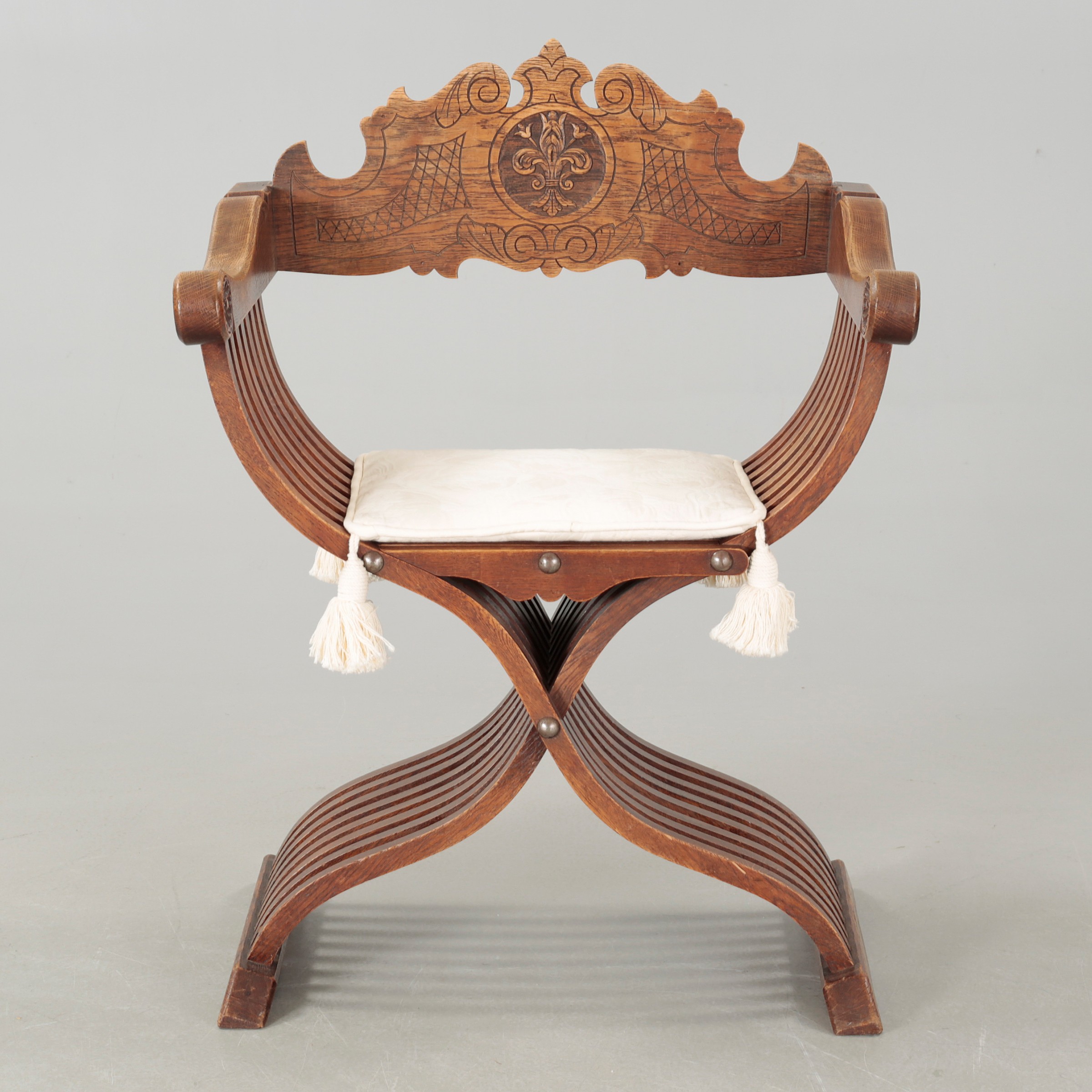
Savonarola chair (αρχές 20ού αιώνα) | Πηγή εικόνας: d2mpxrrcad19ou.cloudfront.net
Παρόμοιας σπουδαιότητας ήταν και τα παραγόμενα αντικείμενα κατά την περίοδο του Εξωτικισμού -κίνημα που ήρθε ως απόρροια των μεγάλων ανακαλύψεων. Έτσι είναι συχνή η χρἠση υλικών όπως το μπαμπού, το οποίο χρησιμοποιούνταν για την κατασκευή πλεκτών επίπλων, προφανώς ως άμεση παραπομπή στους εξωτικούς πολιτισμούς που ανακαλύφθηκαν από τους Ευρωπαίους. Εδώ, η επιθυμία της πολιτισμικής οικειοποίησης γίνεται εμφανής μέσω αυτών των σχεδιαστικών τάσεων της εποχής, κατά την οποία η ελίτ θέλει να δείξει τη θέση της μέσω των επίπλων που διαλέγει.
Έτσι, είναι αναμενόμενο να συναντάμε πάντα περίτεχνα σχέδια -των οποίων η κατασκευή ήταν χρονοβόρα αλλά και δαπανηρή- σε οικίες της αριστοκρατίας και της αναδυόμενης άρχουσας τάξης, με την πλειονότητα των καθισμάτων που προορίζονταν για την καθημερινότητα των υπολοίπων, να παραμένει δυστυχώς άγνωστη. Κατά πάσα περίπτωση, αυτά θα ήταν ξύλινα, λιγότερο πολύπλοκα στο σχέδιό τους και χωρίς κάποια ιδιαίτερη διακοσμητική διάθεση.
Περνώντας όμως οι αιώνες, και με την άρχουσα τάξη να παραπαίει, ο σχεδιασμός φαίνεται να ακολουθεί τις αλλαγές που παρατηρούνται στην κοινωνία. Από εδώ και στο εξής, όλα τα αντικείμενα -συμπεριλαμβανομένης της καρέκλας- στρέφονται σταδιακά προς την απλότητα του σχεδιασμού, ο οποίος θα πρέπει να είναι γρηγορότερος και ως επί το πλείστον φθηνότερος. Σε αυτό το χρονικό σημείο συναντάμε και το έργο του Thonet. Ο Γερμανοαυστριακός σχεδιαστής θεωρείται ο εισηγητής του «μοντέρνου επίπλου», αφού εφήρμοσε μία νέα τεχνική στην κατασκευή της καρέκλας. Μέσω μεταλλικών καλουπιών, που βοηθούσαν στο λύγισμα του ξύλου, ο Thonet κατάφερε να συμβάλει στην παραγωγή καθισμάτων, που ναι μεν είχαν μια διακοσμητική διάθεση -μέσω των καμπυλών που θύμιζαν φυτικά μοτίβα-, από την άλλη όμως το εκάστοτε αντικείμενο μπορούσε να συναρμολογηθεί από τον αγοραστή του, μειώνοντας έτσι αισθητά την τιμή του. Χαρακτηριστικό παράδειγμα αυτής της πρακτικής -που θα μπορούσε να θεωρηθεί ως «πρόγονος» των σημερινών αλυσίδων με knock-down έπιπλα- είναι η γνωστή καρέκλα Model 14, του 1859. Ο σκελετός της καρέκλας είναι κατασκευασμένος από ξύλο οξιάς, ενώ το κάθισμα είναι πλεκτό από raffia. Και τα δύο υλικά είναι προσιτά από οικονομική άποψη και παράλληλα καθιστούν τη χρήση της εύκολη, αφού, όπως ξέρουμε, ο συγκεκριμένος τύπος καρέκλας συναντάται ακόμα παντού, από τα κοσμοπολίτικα καφέ της Βιέννης ως τις εκκλησίες όλης της Ευρώπης.
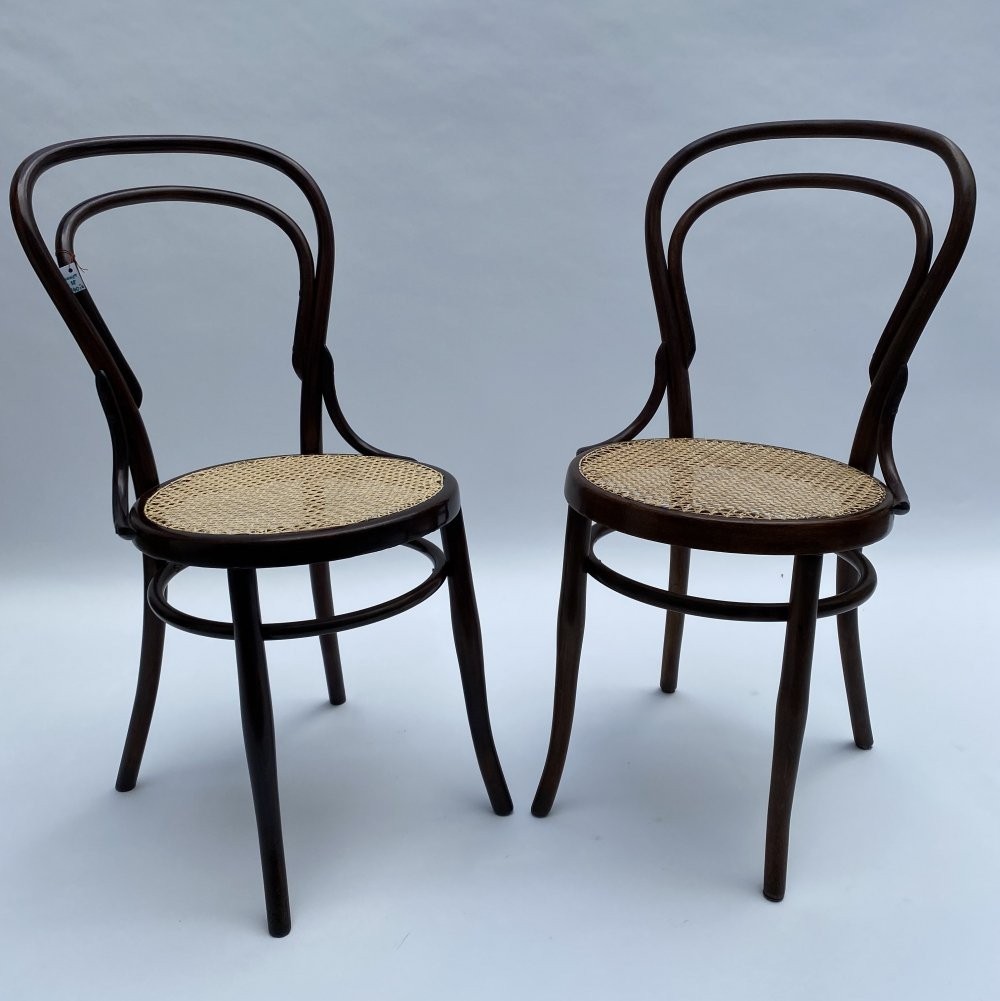
Καρέκλες τύπου Model 14, της δεκαετίας του 1930 | Πηγή εικόνας: vntg.com
Ωστόσο, οι ακριβότερες και πιο βαριές καρέκλες δεν έπαψαν να κατασκευάζονται. Ο William Morris επέμενε στον σχεδιασμό μεγαλύτερων και πιο δυσκίνητων επίπλων, των οποίων οι τιμές ήταν αρκετά υψηλές. Παράδειγμα αποτελεί η λεγόμενη Morris chair (1866), μία αρκετά πρωτότυπη σχεδιαστικά καρέκλα, στην οποία η ανάκλιση της πλάτης ρυθμίζεται, καθιστώντας τη βολική στη χρήση. Ωστόσο, ο τρόπος και τα υλικά κατασκευής της ανεβάζουν αρκετά την τιμή, καθιστώντας την όχι και τόσο προσιτή στο αγοραστικό κοινό της εποχής.
Τι συμβαίνει όμως στο τέλος του 19ου αιώνα; Υπάρχουν μήπως ουσιαστικότερες αλλαγές στην τοποθέτηση της καρέκλας στον χώρο, αλλά και την ιστορική περίοδο;
Από τον Saarinen στον F. L. Wright
Με το πέρασμα στον 20ό αιώνα, ο κόσμος φαίνεται να αλλάζει ριζικά, με αυτό να αποτυπώνεται και στις τέχνες. Το κίνημα του Art Nouveau προσπαθεί να απαγκιστρώσει την τέχνη από το παρελθόν, κρατώντας, όμως, την ιδέα της πλήρους ενότητας, μιας ενότητας που συναντάται παντού. Με αυτό τον τρόπο, για τους σχεδιαστές του νέου κινήματος κανένας χώρος δεν μπορεί να νοείται τελειωμένος, αν δεν ολοκληρωθούν όλες οι εργασίες στο εσωτερικό του, που φυσικά συμπεριελάμβαναν και τα έπιπλα. Σχεδιαστές, όπως ο αρχιτέκτονας Eliel Saarinen, αρχίζουν να πειραματίζονται με τον τρόπο σχεδιασμού της καρέκλας, τολμώντας περισσότερο περίεργα μοτίβα και κατασκευαστικά σχέδια, που πάντα ακολουθούν φυτικά -έστω και αφηρημένα-μοτίβα.
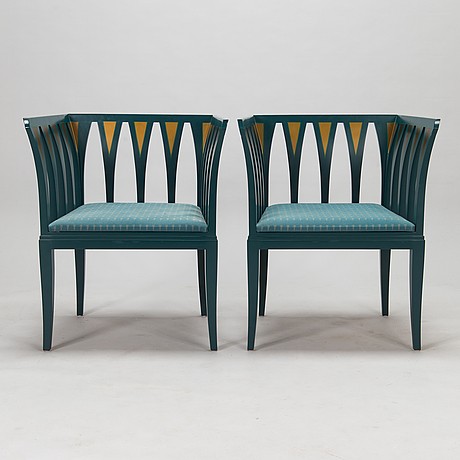
Σχέδιο του Eliel Saarine (περ. 1929) | Πηγή εικόνας: bukowskis.com
Παράλληλα, ο Charles Rennie Mackintosh, αν και κινούμενος στα πλαίσια του Art Nouveau, ακολουθεί ένα πιο λιτό και γεωμετρικό σχέδιο. Ο Mackintosh είναι αυτός που εισάγει την πολύ ψηλή πλάτη στις αμιγώς ξύλινες καρέκλες του, οι οποίες είναι κομψές και απέριττες, χωρίς όμως να χάνουν τη μεγαλοπρέπειά τους. Η Hill chair (1903) αποτελεί και την κορωνίδα των σχεδίων που επιμελήθηκε ο C.R.M.. Η λευκή, ξύλινη καρέκλα σχεδιάστηκε για να τοποθετηθεί στο κατάλευκο δωμάτιο της οικίας Hill, που βρίσκεται στο Helensburgh της Σκωτίας. Το χρώμα της ακολουθεί ακριβώς την ιδεολογία της ενότητας του χώρου που πρέσβευε ο Mackintosh, ενώ η ιδέα της φύσης ενυπάρχει πολύ διακριτικά στο σχέδιό της, και ο διάκοσμος της πλάτης έχει πάντα μία κατάληξη, όπως και όλα τα πράγματα στη φύση. Την ίδια τακτική φαίνεται να ακολουθούσε και για τον σχεδιασμό καθισμάτων σε άλλα κτίρια, όπως στο The Willow Tea Rooms της Γλασκώβης, με τις καρέκλες να κερδίζουν τον επισκέπτη λόγω της περίεργης μορφής τους. Ωστόσο, δεν μπορεί να παραβλεφθεί το γεγονός ότι, όσο ενδιαφέρουσες καλλιτεχνικά ήταν οι δημιουργίες του -αφού για πρώτη φορά έχουμε έναν χωρικό διαχωρισμό μέσω της επίπλωσης-, τόσο έχαναν στον τομέα της χρηστικότητας, αφού για πολλούς ήταν άβολες και κουραστικές.

Καρέκλες στο The Willow Tea Rooms | Πηγή εικόνας: thetimes.co.uk
Στην άλλη άκρη του Ατλαντικού, ο Frank Lloyd Wright, επηρεασμένος από τον Mackintosh, στοχεύει και αυτός στην ανάδειξη της ενότητας του χώρου, εντάσσοντας τις χειροποίητες καρέκλες -όμοιες με αυτές του Σκωτσέζου συναδέλφου του, αλλά εμφανώς πιο βαριές- στο γενικότερο πλαίσιο της εσωτερικής διακόσμησης. Όμως, και ο F. L. Wright φαίνεται πως παραγκώνισε την άνεση, αφήνοντας χώρο σε αναγκαίες αλλαγές, τόσο στιλιστικές όσο και κατασκευαστικές. Έτσι, έπρεπε να βρεθεί ένας τρόπος προσέγγισης του λιγότερο εύρωστου οικονομικά κοινού στα καινούρια έπιπλα, τα οποία θα ήταν πλέον πιο άνετα.
Το πέρασμα σε μία δύσκολη εποχή
Από τις αρχές του 1900 ως και περίπου το 1920, έχουμε την ανάδυση στην Ευρώπη νέων καλλιτεχνικών στυλ. Η απόλυτη γεωμετρία, η ανάγκη οριοθέτησης των χώρων και η αυστηρότητα των γραμμών, ίσως αντικατοπτρίζουν τη δύσκολη περίοδο που γνώρισε η Ευρώπη. Ο Α’ Παγκόσμιος πόλεμος έφερε αλλαγές στον τρόπο προσέγγισης της ζωής και της κοινωνίας και επιδείνωσε τις συνθήκες ζωής, απομακρύνοντας τους ανθρώπους από την εμμονή στην άσκοπη διακοσμητικότητα των αντικειμένων. Αυτή η στροφή υπογραμμίστηκε από το De Stijl, κατά το τέλος του Μεγάλου Πολέμου. Στον τομέα του design, ο Gerrit Rietveld έθεσε τις βάσεις για μία νέα μορφή καρέκλας, με τη Red and Blue Chair (1917) να γίνεται η «καρέκλα του 20ού αιώνα». Σύμφωνα με τον ίδιο, σκοπός της ήταν η άνεση και η αίσθηση αυτοτέλειας του τελικού αποτελέσματος, αν και η καρέκλα αποτελούνταν από μεμονωμένα στοιχεία, ενωμένα μεταξύ τους. Επιπλέον, λόγω της ξύλινης κατασκευής, η καρέκλα φαίνεται να ήταν αρκετά οικονομική και προσιτή για το ευρύ κοινό.

Red and Blue Chair | Πηγή εικόνας: wright20.com
Στα χρόνια του Μεσοπολέμου, η σχολή του Bauhaus και το έργο του Le Corbusier έφεραν μία νέα πνοή στον σχεδιασμό, με τη χρήση του χάλυβα. Ως εκ τούτου, χαλύβδινοι σωλήνες αντικατέστησαν το ξύλο σε νέες άνετες καρέκλες, που τώρα μπορούσαν να κατασκευάζονται μαζικότερα, ούτως ώστε να απευθύνονται σε μεγαλύτερο αγοραστικό κοινό. Χαρακτηριστικότερες είναι οι Wassily chair (1925) και Cesca chair (1928) του Marcel Breuer, των οποίων η καθαρότητα της φόρμας και ο σχεδόν ορθοπεδικός σχεδιασμός είναι εμφανή. Καινοτόμο, αισθητικά και κατασκευαστικά, ήταν το κάθισμα του Mies van der Rohe, Barcelona chair (1929), η διαχρονικότητα του οποίου είναι αναμφισβήτητη, αν και ξέφευγε αρκετά από το μοτίβο του «προσιτού επίπλου».
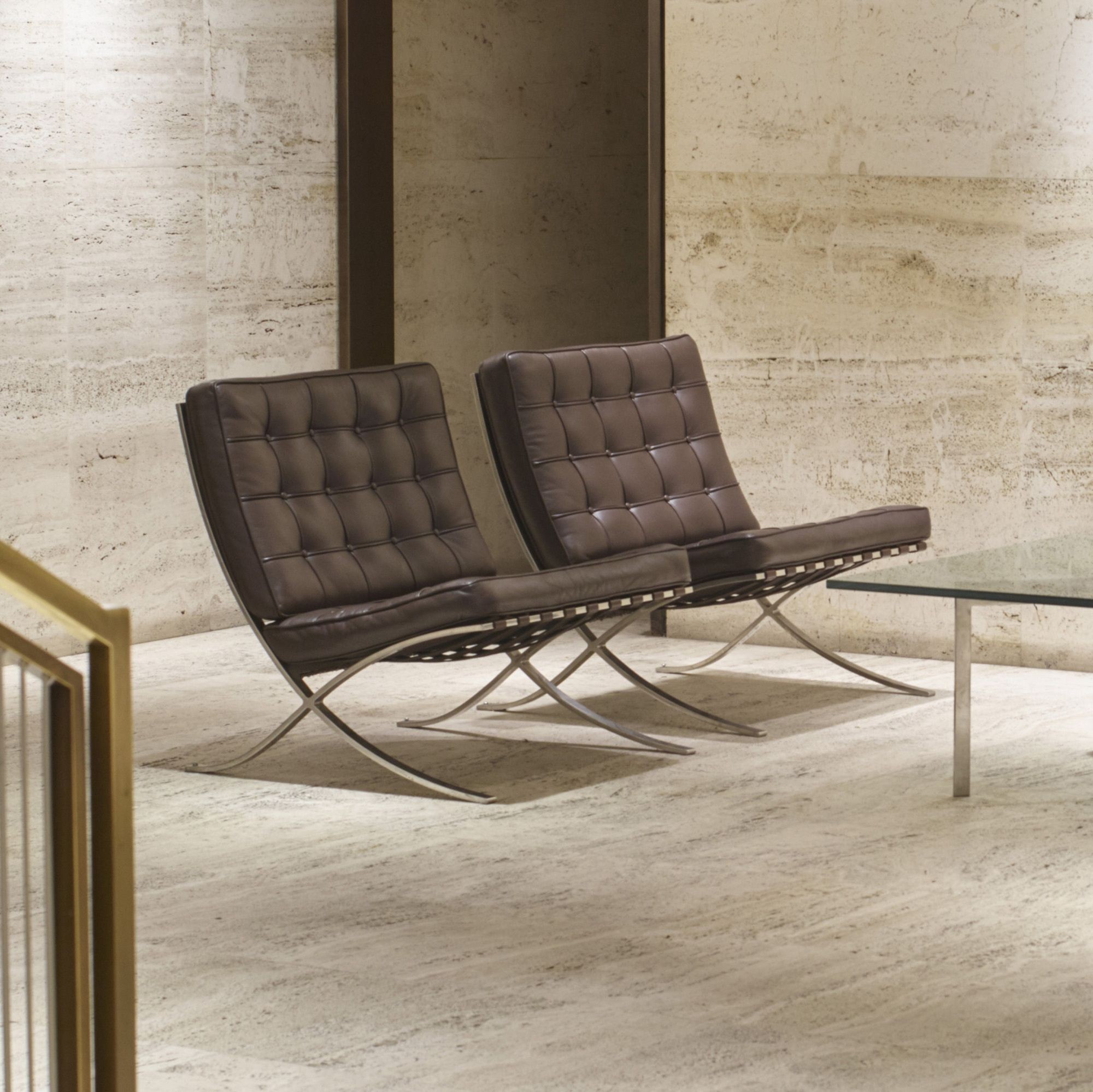
Barcelona chair (έτος σχεδιασμού: 1929) | Πηγή εικόνας: i.pinimg.com
Μετά το τέλος του Β’ Παγκοσμίου πολέμου και τις καταστροφικές του συνέπειες, το δίδυμο Charles και Ray Eames (The Eames Office) έκαναν μία στροφή στον τρόπο προσέγγισης του σχεδιασμού. Έχοντας ως παράδειγμα τη μορφή ενός νάρθηκα ποδιών -τον οποίο κλήθηκαν, από το Ναυτικό των ΗΠΑ, να σχεδιάσουν το 1941-, προχώρησαν στην κατασκευή ενός τύπου καρέκλας που στόχευε στην ανάμειξη του στυλ με την άνεση. Η Lounge Chair (1956) είναι ορόσημο του design και μία άκρως «ποθητή» καρέκλα για πολλούς, αφού συνδυάζει όλα αυτά που ήθελαν να πετύχουν οι προηγούμενοι designers: άνεση, ελαφρύ σκελετό, κομψότητα και εύκολη ενσωμάτωση στον χώρο.

Lounge Chair (1956) | Πηγή εικόνας: einrichten-design.com
Φυσικά, δεν πρέπει να αγνοηθεί το γεγονός ότι, οι κοινωνικοοικονομικές συνθήκες της εποχής και η πολλά υποσχόμενη νέα εποχή μετά τους πολέμους επέτειναν την ανάγκη για την ύπαρξη πιο προσεγμένων επίπλων, αφού τώρα και το κοινό αναζητούσε άνεση και πολυτέλεια.
Είναι το μέλλον πολλά υποσχόμενο;
Όπως είδαμε, κατά τη διάρκεια των αιώνων η καρέκλα αλλάζει, γίνεται σύμβολο status και διακοσμητικό αντικείμενο. Ο κόσμος μας τώρα διαφοροποιείται με ταχύτατους ρυθμούς, καθιστώντας τις νέες προτάσεις επιτακτικότερες και εστιασμένες σε ένα διευρυμένο αγοραστικό κοινό. Ειδικά κατά την περίοδο του COVID-19 και τη μετἀ-κόβιντ εποχή, με τα γραφεία να μεταφέρονται στο σπίτι, η εύρεση ευφάνταστων λύσεων είναι αναγκαία, αφού η καθιστική ζωή είναι σύνηθες φαινόμενο. Προφανώς, designers, όπως ο Marc Ange και ο Tom Dixon, είναι παρόντες και καινοτομούν, αλλά το ερώτημα τού πώς θα καταστήσουμε τη ζωή μας άνετη, με αντικείμενα που είναι κομψά, ποιοτικά και προσιτά, είναι εδώ και περιμένει μία απάντηση.
Πηγές / Περαιτέρω ανάγνωση
Molded Plywood Leg Splint. Από: eamesoffice.com.
Ακύλα Ε.. Από: elenakyla.wordpress.com.
Dr. Cramer C. & Dr. Grant K.. Από: khanacademy.org.
Hess R.. Από: disd.edu.
Ancient Roman Chairs & Stools. Από: furniturestyles.net.
The Design Museum. Thonet Chair No. 14. Από: designmuseum.org.
Escritt, Stephen. Art Nouveau. London, Phaidon, 2000.




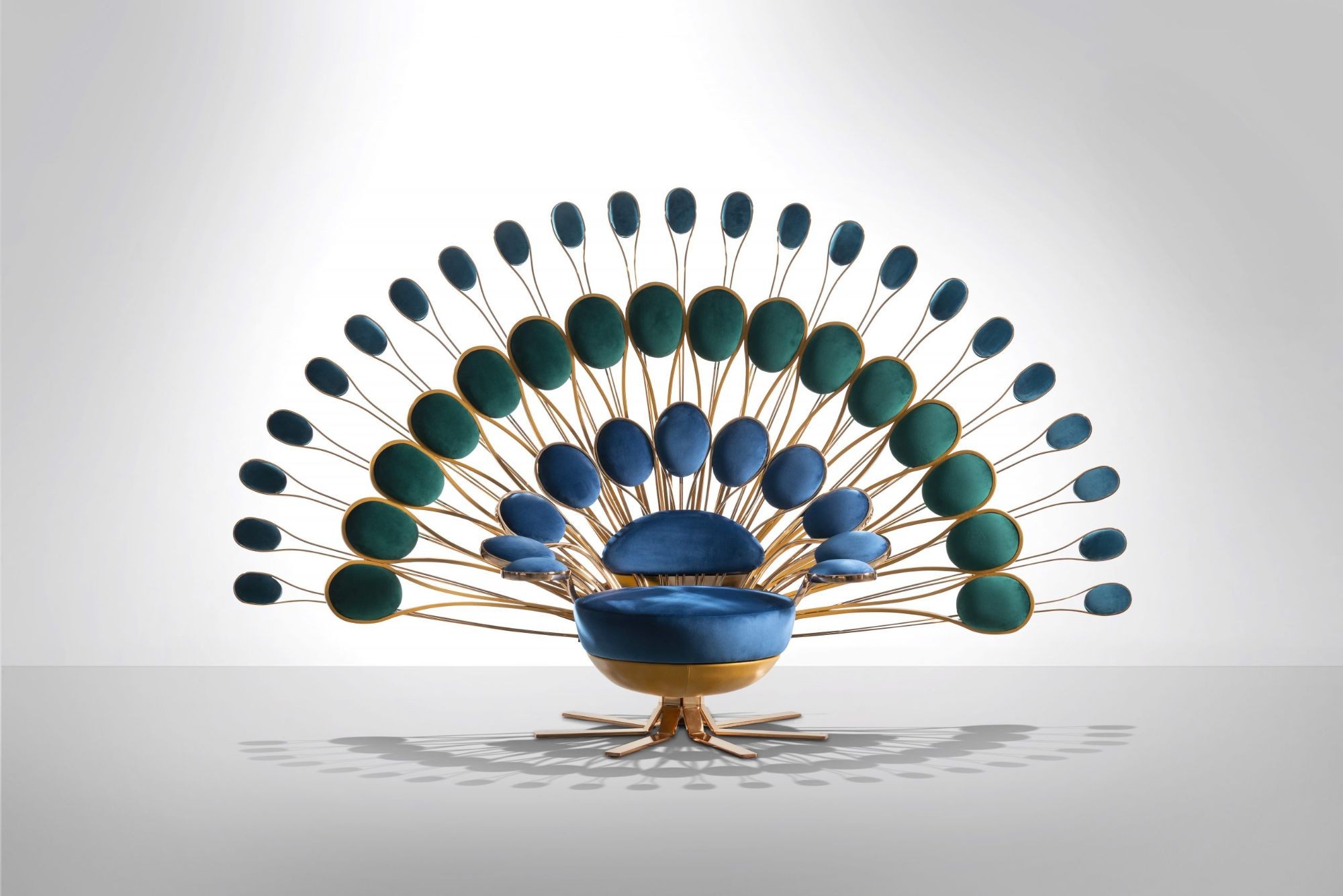


.jpg)
.jpg)